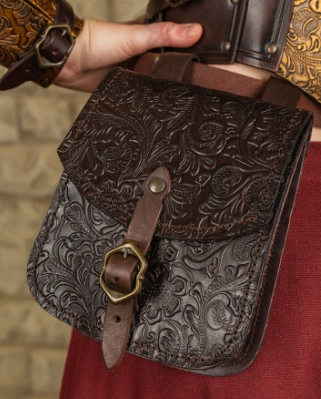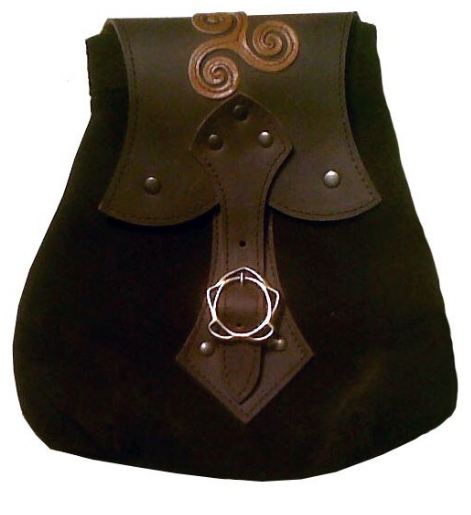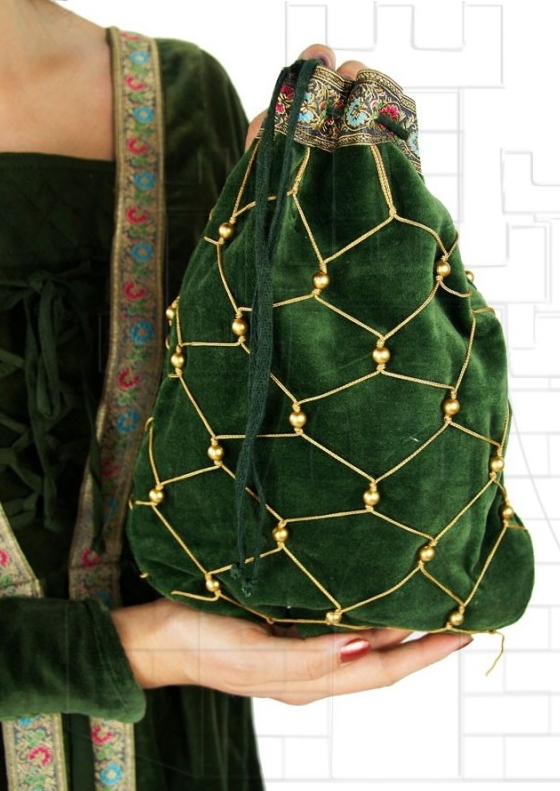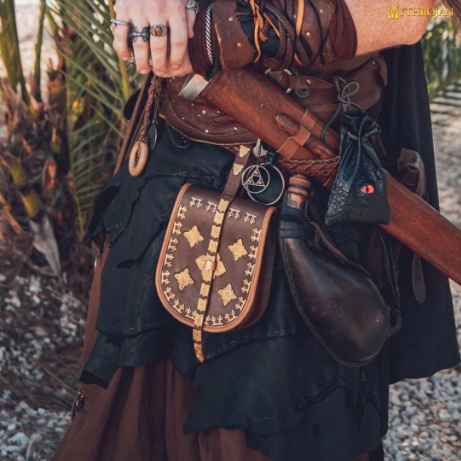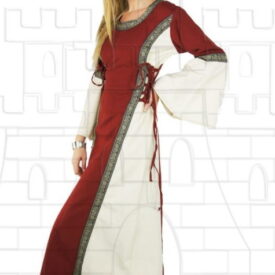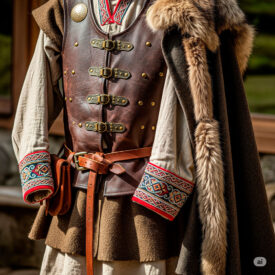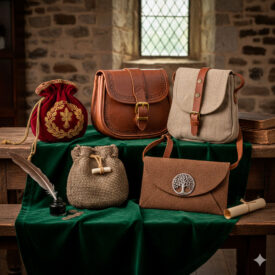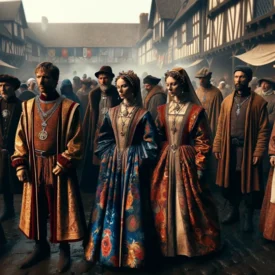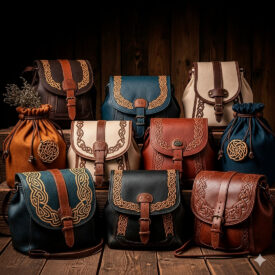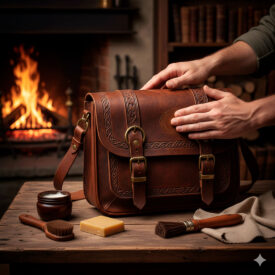Imagine life in the Middle Ages. How did men and women keep their personal belongings when clothing, for the most part, lacked pockets? The answer is fascinating and complex: the bag, a constant companion since the dawn of civilization, although its shape and function have drastically changed over time. In fact, the use of bags is as old as humanity itself, with evidence showing that nomadic communities already used a kind of leather pouch, known as an Alforja, for gathering food.
Although the bag is a fundamental accessory in our daily lives today, its relevance in history is often underestimated. Medieval bags are a clear example of how such a simple object can reflect profound social, economic, and artistic transformations throughout history. Join us on this journey to discover the rich history of medieval bags, their evolution, and the role they played in a society without integrated pockets.
A Necessity: Beyond Fashion
In the Middle Ages, bags were not just a fashion accessory, but a practical and almost always hidden necessity. With tight trousers that made it impossible to keep objects inside, men would often carry small bags or purses tied to their waist. Women also used them, though more discreetly, often hidden among the folds of their wide dresses, tunics, and cloaks. However, in the Late Middle Ages (11th to 15th centuries), the bag began to be displayed more often, adapting to clothing and ceasing to be a mere utilitarian object to become a complement that reflected personality and status.
Among the most beautiful and useful accessories of medieval outfits are the bags. Bags are defined as generally small hand pouches, made of leather, fabric, or other materials, usually with a closure and often a handle, used to carry money, documents, personal items, etc. While they were originally used by men, their use extended to women and, currently, they are used by both sexes in a very natural and practical way. For many years, the bag was exclusively used by women (especially during the second half of the 20th century), but today it is commonly used by both men and women.
The best bags are handmade from genuine leather. They come in all shapes, colors, and sizes. They are not only useful, but also beautiful and always add a touch of elegance and distinction.
Materials and Social Status: The Silent Language of the Bag
The choice of materials for a medieval bag spoke volumes about its owner.
- For daily use, bags were commonly made with deer or pigskin.
- The wealthier classes chose more sophisticated materials. Byzantine influence, for example, brought the use of silks and embroidery with gold and silver threads, and even gemstone ornamentation for handbags.
- On the other hand, the influence of peoples conquered by Islam manifested itself in greater simplicity, using mainly leather. Among leathers, goatskin was preferred by the richer, while cowhide was for the less affluent.
- Peasants, using their ingenuity, resorted to any available material, from carved wood to skins of common animals such as weasels, rabbits, or lambs.
Textile fibers such as linen, wool, and cotton were also used, woven and dyed with onion skins or plant juices. For the humbler classes, colors were usually grey or brown, while the wealthier enjoyed a full range of colors, enriched with gold, silver threads and the inlay of precious stones.
Types of Medieval Bags: Diversity and Function
The medieval period saw the birth and evolution of various types of medieval bags. Each with a specific function and distinctive design:
- Alms purses: Small bags, mainly used by nobility, whose name comes from the custom of carrying money to give to the poor.
- Waist bags (Girdle Purses): These were leather bags with one or two handles on top, designed to attach to the belt. Although common for both men and women, two-handled ones were predominantly male. Their size and design varied greatly, from simple forms for peasants and craftsmen to more elaborate designs for the nobility.
- Bags with compartments and internal purses: Many waist bags had multiple compartments. The inner panels were often made from softer skins, such as calf or goatskin, and sometimes supplemented with suede or textiles (like linen) for added flexibility. Small purses (Pouchlets) were little pouches sewn inside the compartments, ideal for storing coins.
There is also the backpack, a type of luggage that can be carried on the back with two straps passing over the shoulders. It is often preferred to use backpacks instead of bags for carrying heavy loads over long periods, as the shoulders bear the weight better than the hands, thus relieving the spine of weight that could cause harm.
The Art of Medieval Decoration
Bags, while functional, were also a canvas for artistic expression and status. Decorations on medieval bags, although relatively rare, were elaborate and varied. Techniques included:
- Relief stamping: Creating medallions or motifs pressed into the leather, often with wooden molds for possible series production.
- Engraving and stenciling: Lightly cutting out the outline of letters or designs and pressing the surrounding leather to create a raised background. Cryptic inscriptions and the word “AMOURS” have been found.
- Stamped with dies: Such as fleurs-de-lis or eagles stamped on suspension loops.
- Figurative designs: Images such as birds (possibly falcons, symbolizing boldness).
- Punched or perforated decoration: Creating patterns with holes made by an awl.
- Low-relief lines: The moistened leather was placed over molds of leather strips, wood or wire and pressed with bone tools to create a permanent design. Only vegetable-tanned leather could preserve these decorations.
These decorations not only embellished the object, but also communicated messages about its owner and his or her place in society. Medieval leather bags were widely used not only by nobles, but also by peasants and merchants.
Secrets Revealed by Archaeology
Thanks to archaeological excavations, especially in places with wet, oxygen-free soils like Dordrecht, we have been able to unearth valuable fragments of medieval bags. Although many are found fragmented due to the decomposition of sewing threads, these findings allow us to reconstruct their design and functionality.
For example, waist bags were made with sturdy leather (such as cowhide) for the exterior, and softer leather (calf or goat) for the internal compartments. The various parts of the bag, along with the suspension handles, were joined with a leather binding, and up to four different joining methods have been identified. Some bags also had a flap, offering extra protection against thieves, although a “professional” could outsmart it.
No one doubts that today bags and backpacks are essential for carrying frequently used items such as wallets, purses, keys, documents, cell phones, glasses, etc. Saddlebags preceded bags and were more rustic as they were made of cloth, large and square-shaped to carry ceramics, food, and heavy objects.
Purchase and Usage Recommendations
Currently, medieval bags and backpacks are made of leather to beautifully complement medieval costumes for reenactments, parties, and medieval weddings. Medieval leather bags and backpacks are so attractive and practical that nowadays many people buy them for everyday use, both men and women. The quality, price, and beauty ratio of a medieval leather bag is excellent, making it an ideal choice for those looking for an accessory with history and style.
If you’re looking for an accessory that combines functionality with history and style, don’t hesitate to visit our medieval bags section. You’ll find a wide range of products that allow you to carry the essence of the Middle Ages in your daily life or perfectly complete your outfit for special events. We also invite you to explore our other medieval accessories to enrich your historical experience.

